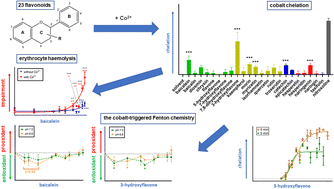3-Hydroxyflavone is a mildly active and safe cobalt chelator while cobalt markedly enhances baicalein toxicity toward erythrocytes†
Abstract
Cobalt intoxication can occur after its release from metal-based prostheses, which is generally clinically severe. Therefore, there is a need for the development of a cobalt chelator since there are currently no approved drugs for cobalt intoxication. As flavonoids are known for their metal chelating properties and safety, the screening of cobalt chelating properties was performed in a total of 23 flavonoids by our recently developed new spectrophotometric assay. Further assessment of positive or negative consequences of cobalt chelation was performed both in vitro and ex vivo. Six and thirteen flavonoids significantly chelated cobalt ions at pH 7.5 and 6.8, respectively. Baicalein demonstrated a significant activity even at pH 5.5; however, none of the flavonoids showed chelation at pH 4.5. In general, baicalein and 3-hydroxyflavone were the most active. They also mildly decreased the cobalt-triggered Fenton reaction, but baicalein toxicity toward red blood cells was strongly increased by the addition of cobalt. Quercetin, tested as an example of flavonoid unable to chelate cobalt ions significantly, stimulated both the cobalt-based Fenton reaction and the lysis of erythrocytes in the presence of cobalt. Therefore, 3-hydroxyflavone can serve as a potential template for the development of novel cobalt chelators.



 Please wait while we load your content...
Please wait while we load your content...